DWDM EXFO FTBx-5245, 5255 Optical Spectrum Analyzer Module Series
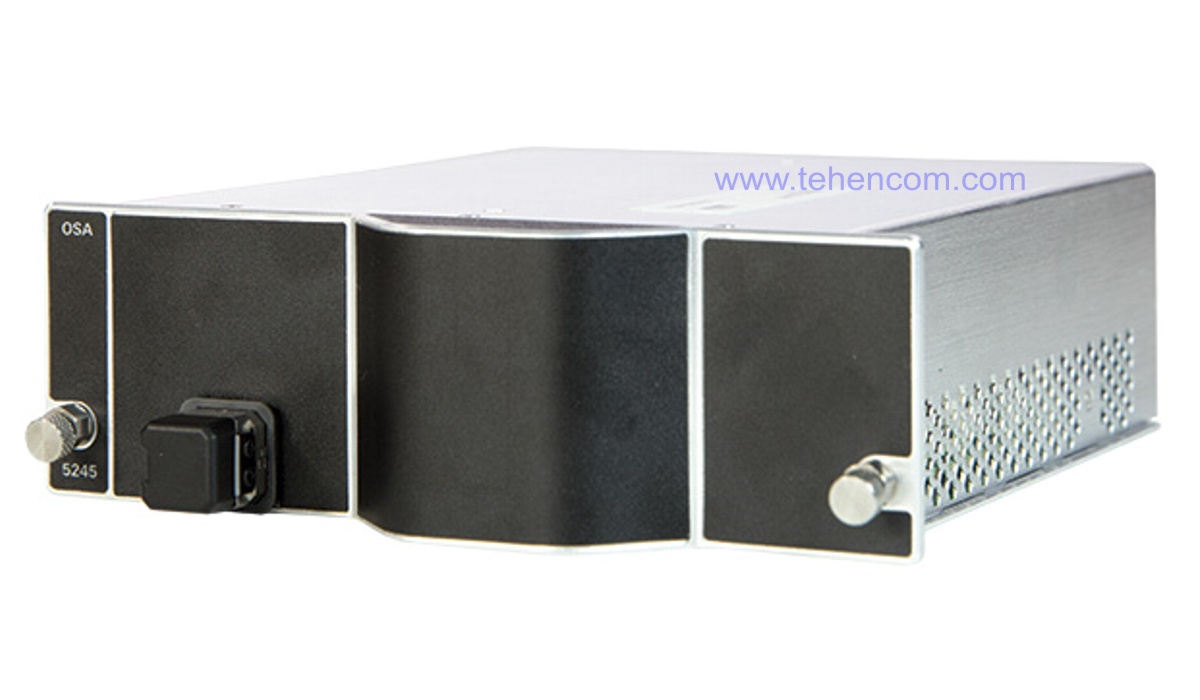
Product code: 1000333
Add item to cart. Our specialist will coordinate with you the complete set, tell you the price and delivery time.
Price on request
SHORT DESCRIPTION
Optical spectrum analyzer modules EXFO FTBx-5245 and FTBx-5255 are the most functional in the line of EXFO analyzers. They provide a solution for a wide range of tasks: from the development and research of lasers to the testing of working DWDM highways with speeds of 400G per channel.
The FTBx-52x5 series includes three module modifications: the simplest FTBx-5245 without a polarization controller, the more functional FTBx-5245-P with a polarization controller, and the most functional FTBx-5255 with a polarization controller and the ability to measure OSNR (signal-to-noise ratio) directly in operating networks 40G/100G/200G/400G.
To work with the optical spectrum analyzer module, it must be installed in one of the measurement platforms: EXFO FTB-2, EXFO FTB-2 Pro or EXFO FTB-4 Pro. In the platform, the module occupies 2 slots, so when installed in a four-slot platform EXFO FTB-4 Pro 2 more slots will remain free, for example, for installing a data transfer protocol analyzer module. You can download a full description of all the characteristics of the FTBx-52x5 series modules below on this page in the section Documentation.
Main characteristics:
Wavelength range: 1250 nm - 1650 nm.
Dynamic Range: -80 dBm to +18 dBm.
Wavelength measurement error: 0.01 nm. Power measurement error: 0.5 dB.
DWDM support with channel spacing from 25 to 200 GHz (models FTBx-5245 and FTBx-5245-P).
DWDM support with channel spacing from 12.5 to 200 GHz (model FTBx-5255).
OSNR measurement for 1G/10G by interpolation method (all models).
OSNR measurement for 10G/40G in-band method (only FTBx-5245-P and FTBx-5255).
OSNR measurement for 40G/100G/200G/400G before commissioning (all models).
OSNR measurement for 40G/100G/200G/400G during operation (FTBx-5255 only).
Standards support: IEC 61280-2-9, IEC 61282-12, YD/T 2147-2010, etc.
Detailed analysis of DWDM, CWDM, ROADM, optical amplifiers (EDFA) and lasers.
Module size: 2 slots. Compatible with EXFO platforms FTB-2 Pro and FTB-4 Pro.
Maximum measurement accuracy and support for the latest standards
Need an analyzer faster and cheaper? see model EXFO FTB-5235.
Necessary easy to measure the power of DWDM channels? see model EXFO MAX-5205.
Want to see the full list? Go to the main page by optical spectrum analyzers.
DETAILED DESCRIPTION
EXFO FTBx-5245 and FTBx-5255 optical spectrum analyzer modules are compatible with the latest EXFO measurement platforms FTB-4 Pro and FTB-2 Pro, which provide fast processing of measurements, a very convenient and thoughtful user interface on a large touch screen and a long operating time from the built-in battery.
The main tasks that the FTBx-5245 and FTBx-5255 analyzers solve are the commissioning and further maintenance of optical networks using DWDM, CWDM, ROADM, OTN, etc. The FTBx-5245 and FTBx-5255 analyzers can measure the characteristics of EDFA optical amplifiers , optical filters, optical input-output multiplexers of channels, spectral properties of lasers.
This figure shows EXFO's range of optical spectrum analyzers and their breakdown by feature and cost. As you can see, the FTBx-5245 and FTBx-5255 models are among the most functional and expensive solutions capable of measuring parameters of networks with speeds 100G, 200G and above.
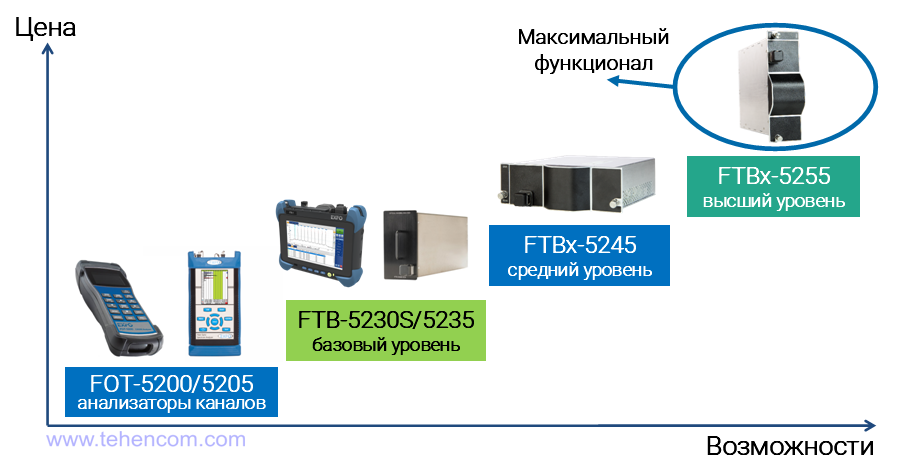
A separate and very important type of measurement that must be carried out in optical networks is the measurement of the signal-to-noise ratio (OSNR), which must be carried out individually for each channel. There are several ways to measure OSNR, which depend on the transmission rate of the channel, the type of signal modulation in the channel, and the structure of the network (for example, the presence of ROADM). This will be discussed further.
By regularly taking measurements at key points in the network and saving graphs of the optical spectrum, you will be able to analyze the stability of its elements and detect devices whose parameters degrade over time. This makes it possible to replace problematic elements in advance and ensure the smooth operation of the entire system.
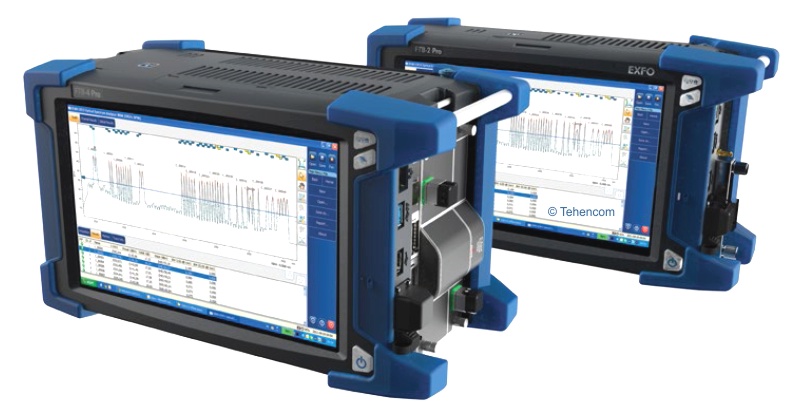
Measurement of DWDM parameters
DWDM (Dense Wavelength Division Multiplexing) technology is the basis of most modern backbone optical networks. EXFO FTBx-5245 analyzer module supports DWDM channel spacing 25 to 200 GHz, and the EXFO FTBx-5255 module supports DWDM with channel spacing 12.5 to 200 GHz. Because most modern DWDM networks are 50 or 100 GHz channel spacing, the FTBx-52x5 Series Spectrum Analyzers are fully compatible with existing optical networks and ready to work on the more advanced networks that will emerge in the future.
The screenshot below shows the spectrum of a typical DWDM system with a channel spacing of 100 GHz (about 0.8 nm). The transmission rate in each channel is 10G, plus reconfigurable optical input / output multiplexers (ROADM) are used. At the top is a graph of the spectrum (optical power in dBm versus wavelength in nm). The graph clearly shows all active channels (30 pcs.) And about a dozen inactive channels.
Below the graph is a table with detailed data for each channel: channel center wavelength, channel power, signal to noise ratio (OSNR), noise level in each channel, -3dB channel width and -20dB channel width. For a specialist, this information makes it possible to quickly assess the health of the network and proactively detect and replace problematic elements, such as EDFA amplifiers and channel I/O multiplexers.
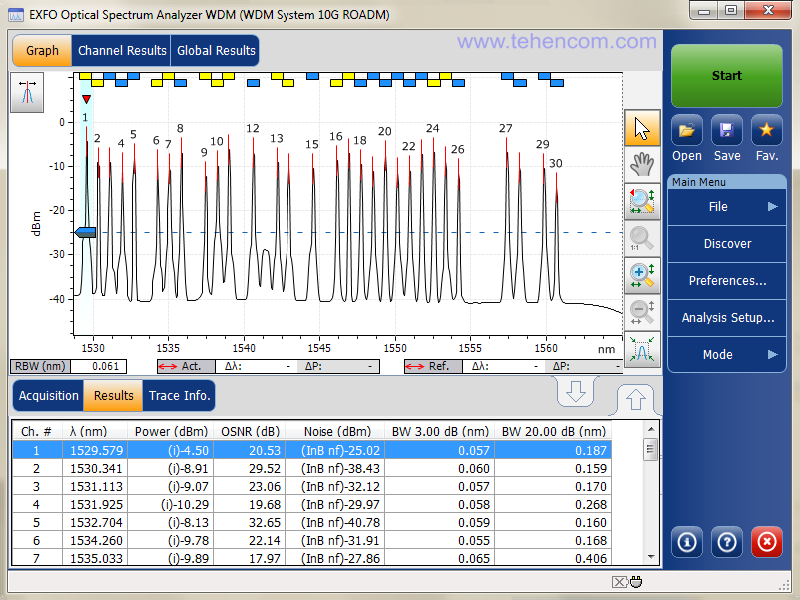
Automatic processing of results with the WDM Investigator option
The appearance of the DWDM spectrum and the table with the measurement results are completely understandable for an experienced specialist. But if you do not have enough experience in this area, then it can be very difficult for you to figure out the numbers and correctly identify the problematic elements of the system. In addition, even an experienced specialist can make a mistake and misinterpret the data obtained during the measurements.
Modern DWDM systems become more complex in two directions at once: the number and density of channels increase, and at the same time the transmission rate in each channel increases, and, accordingly, the signal modulation schemes become more complicated. Even at 40G speed polarization-multiplexed signals (Pol-Mux: polarization-multiplexed) can be used, and for speeds of 100G and above, Pol-Mux signals are used in 100% of cases.
Such a rapid complication of DWDM systems leads to new parasitic effects: the mutual influence of channels on each other and various non-linear effects. And this is in addition to the "standard" set of problems: increased fiber losses, high dispersion, increased amplifier noise, etc.
To simplify and automate the processing of results, as well as to minimize the possibility of random errors, EXFO has developed a software option called the WDM Investigator. This option itself analyzes the state of all channels, checks for the effects of PMD dispersion, channel crosstalk, non-linear depolarization, and channel power leakage. Then, for each channel, a green circle appears next to each parameter if everything is normal, a yellow triangle if a problem may occur, or a red circle if the situation is critical. Using this data, you can quickly identify problematic elements and investigate them in detail. An example of how this option works is shown in this screenshot.
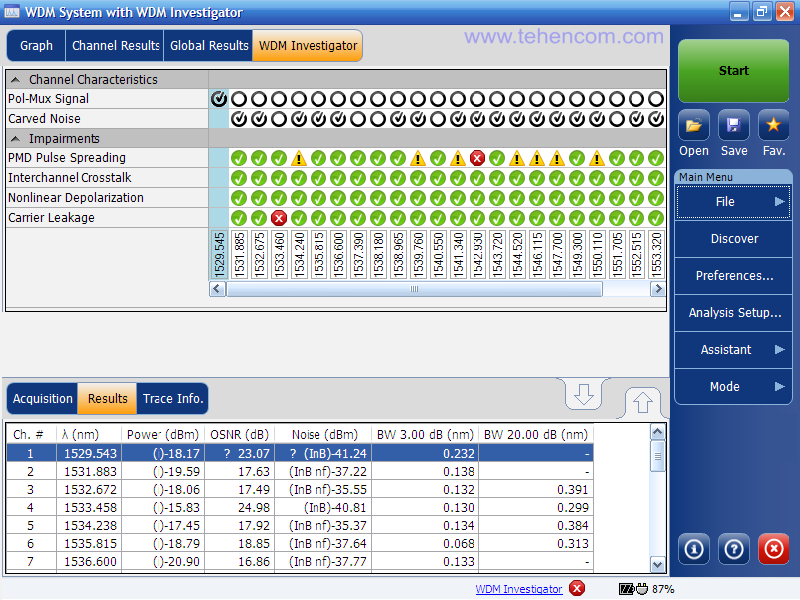
Measurement of optical signal to noise ratio (OSNR)
In DWDM and CWDM systems, the signal-to-noise ratio (OSNR) is an important parameter that is normalized and needs to be checked regularly. The OSNR value directly affects the quality of the optical channel and its ability to transmit information. OSNR measurement allows you to evaluate the status of a DWDM or CWDM link in minutes and allows you to predict the transmission error rate (BER).
There are several methods for measuring OSNR: the interpolation method, the in-band method, and the individual channel mute method (used for Pol-Mux signals). The choice of OSNR measurement method depends on the data rate in the channel, the method of signal modulation used, and the availability of ROADM. The table below collects all the information on the different methods and indicates the suitable module models.

Specifications for EXFO FTBx-5245, FTBx-5245-P and FTBx-5255 modules
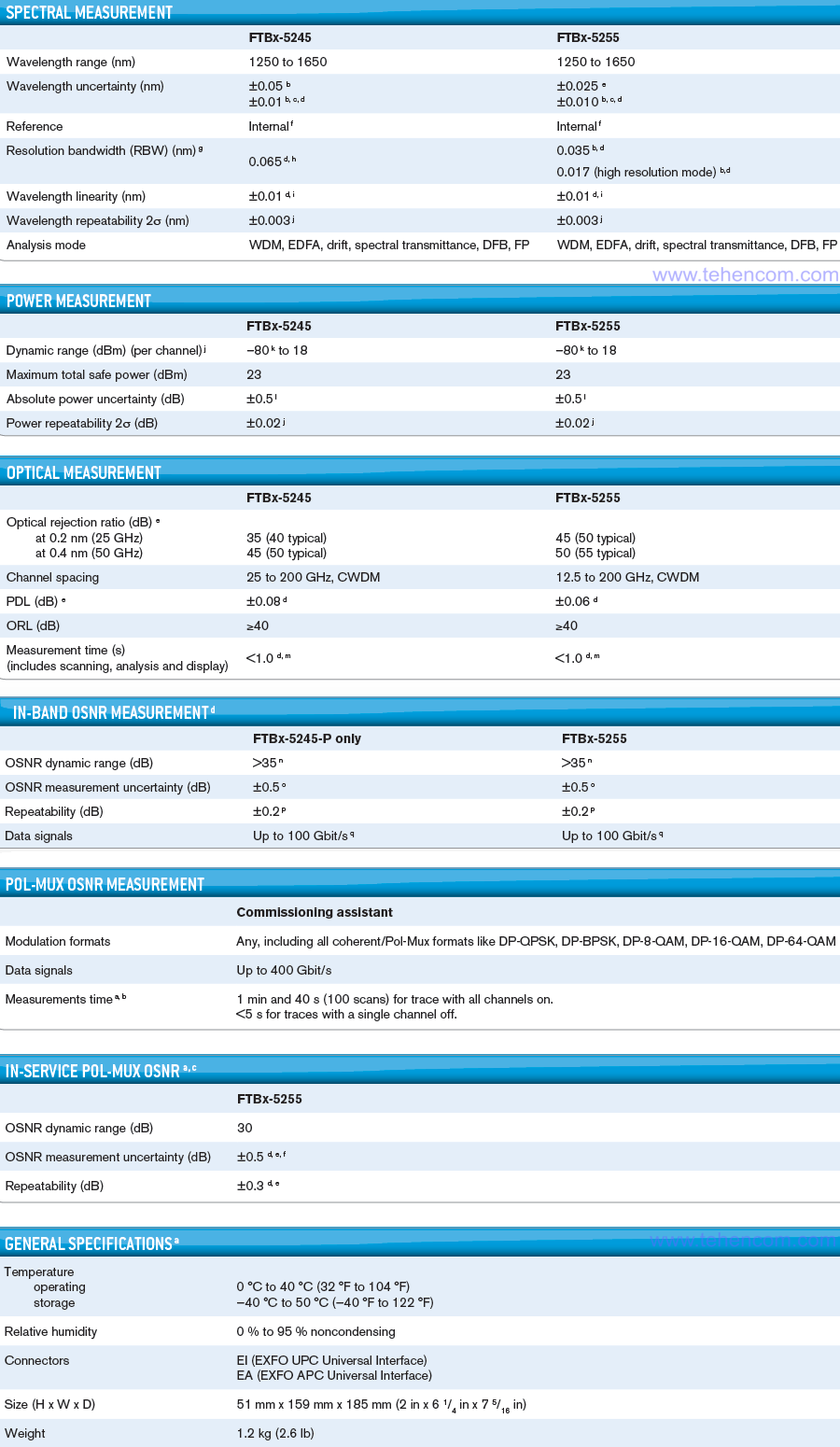
Delivery kit for EXFO FTBx-5245, FTBx-5245-P and FTBx-5255 modules
| Name | Short description |
| EXFO FTBx-5245 | Optical spectrum analyzer module without polarization controller |
| or | |
| EXFO FTBx-5245-P | Optical spectrum analyzer module with polarization controller |
| or | |
| EXFO FTBx-5255 | Optical spectrum analyzer module with polarization controller and the ability to measure OSNR (signal-to-noise ratio) directly in working 40G/100G/200G/400G networks |
| - | User manual in English (electronic) |
| - | Calibration certificate |
| - | 1 year warranty (can be extended to 3 and 5 years) |
To work with any of the FTBx-5245, FTBx-5245-P or FTBx-5255 modules, it must be installed in one of the measurement platforms: EXFO FTB-2, EXFO FTB-2 Pro, EXFO FTB-4 Pro or EXFO LTB-8.
Basic options for EXFO modules FTBx-5245, FTBx-5245-P and FTBx-5255

The figure above shows the main options for the EXFO FTBx-52x5 optical spectrum analyzer modules. Detailed information on all the features of these modules and their options is located below on this page in the section Documentation.
Documentation
This PDF documentation contains the most comprehensive description of the FTBx-5245, FTBx-5245-P and FTBx-5255 Optical Spectrum Analyzer Modules features, specifications and modes of operation.
Description and characteristics of the EXFO FTBx-5245 and FTBx-5255 modules (in English) (8 pages; 1 MB)
EXFO FTBx-5245 and FTBx-5255 User Manual (English) (750 pages; 9 MB)
EXFO FTBx-52x5 Spectrum Analyzer Modules User Manual (in Russian) (810 pages; 8 MB)
And here you can find our tips and other useful information on this topic:
Testing 40G, 100G, 200G and 400G networks - a detailed guide
How to buy equipment cheaper - discounts, special prices, demo and used devices
To simplify the process of choosing an optical spectrum analyzer, you can use our experience and recommendations. We have over 20 years of practical supply experience and can immediately answer many questions about models, options, delivery times, prices and discounts. This will save your time and money. For this it's simple call us or write to us at Email and we will be happy to answer your questions.